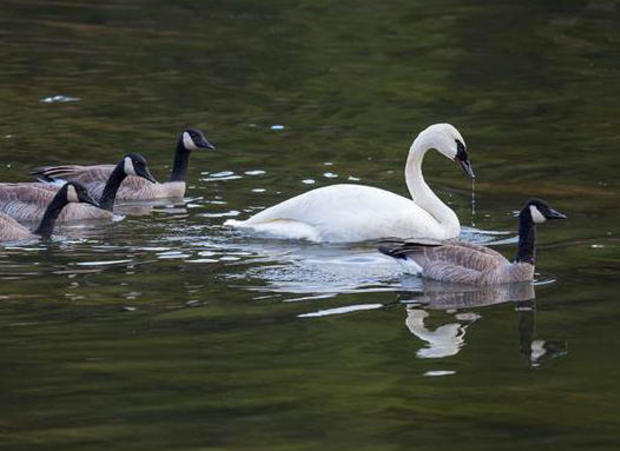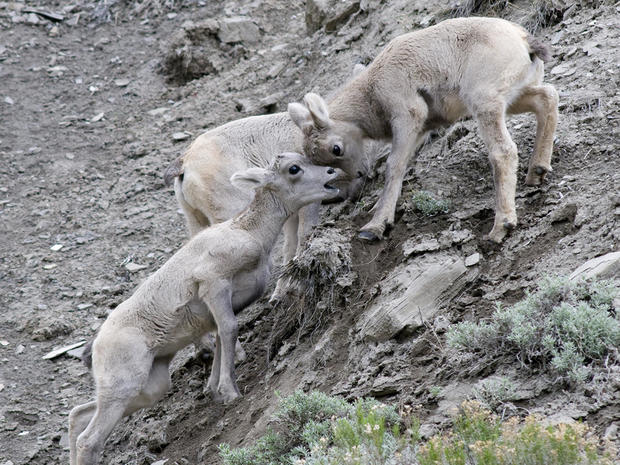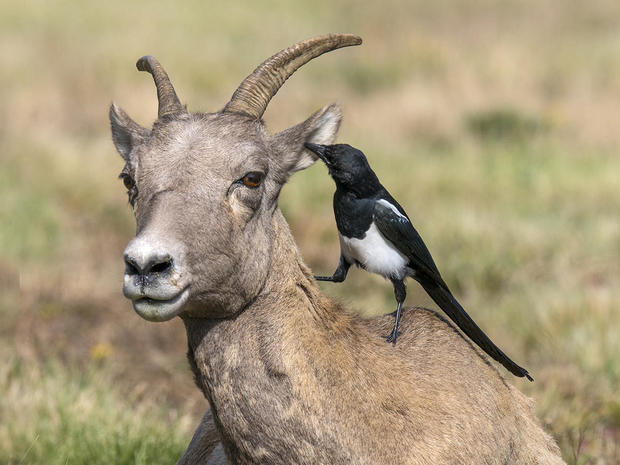Nature up close: Wildlife in the Teton Range
By “Sunday Morning” contributing videographer Judy Lehmberg.
Jackson Hole is a valley between the Teton and the Gros Ventre Mountain Ranges. It was a refuge for early fur trappers during harsh Wyoming winters, and continues to this day to attract wildlife.
The Teton Range is the youngest mountain range in the Rocky Mountains. It began forming about 13 million years ago along the Teton Fault. A fault is simply a big crack in the Earth’s surface that forms when tectonic plates move. The Teton Fault is a north-south fault line which is on the east side of the Teton Range. The Teton Range formed when the two blocks on either side of the fault began to move. The eastern block moved down and under the western block, which rose up and became the Teton Range.
The highest mountain in the Tetons is the Grand Teton. The top of the Grand is 13,775 feet. In total there is now a 30,000-foot difference between the top of the eastern block and the top of the Grand.
Years ago we took students on a six-week field trip where they learned environmental science and plant taxonomy in New Mexico, Arizona, Utah and Wyoming. For a number of them it was their first trip out of hot, humid, industrialized Baytown, Texas.
We learned to anticipate a few things. They always wanted to stop for a snowball fight on the north side of the Grand Canyon, and we loved waiting for the moment they saw the Tetons for the first time. That was so long ago we didn’t have cell phones; we communicated between our three vans with CB radios. It got to be sort of a contest: Who was going to call on their CB first to see if they could stop for a photo? It was always a treat to hear that first excited request for a photo stop. The Tetons are truly one of the most striking mountain ranges on Earth, and I still get excited when I see them.
We are still in contact with some of those students. It was a life-changing experience for many of them. Classroom learning is essential, but nothing beats a field trip if you want students to remember why they should care about their environment.
Two species that call Jackson home in the winter are bighorn sheep and trumpeter swans. Actually, both are present all year; the bighorn sheep move up and down the mountains depending on season and food availability.
The swans nest along Flat Creek north of Jackson. They stay along this spring creek during winter because Flat Creek usually doesn’t freeze over completely. Swans eat aquatic vegetation which they dig up from the stream bottom with their feet. Ducks and geese realize the swans can reach down lower with their feet than they can, and therefore follow them to steal some of the plants they dig up.
Bighorn sheep are the more widely-distributed of the two wild sheep species found in North America (the other is Dall sheep found from British Columbia north into Alaska). Rocky Mountain bighorn sheep (Ovis canadensis canadensis) are the largest, with males weighing over 300 pounds and their horns weighing as much as 30 pounds. As their name implies they live in the Canadian and U.S. Rocky Mountains.
Bighorns are very adaptable sheep. Over time they have evolved into subspecies that have characteristics to fit various climates. They live anywhere from high in the snowy Rocky Mountains down to the deserts of Baja, California. Desert bighorns (Ovis canadensis nelsoni) are smaller and lighter than their mountain counterparts, and have adapted to the extreme desert heat. They can retain water by concentrating urine and reduce moisture in their fecal material. They can go without drinking for more than two weeks. They also dissipate heat more readily from their horns.
Bighorn sheep horns consist of a horny sheath covering highly-vascularized bone. The greater the surface area of the inner bone, the greater the amount of heat dissipation is possible. Desert bighorns have the greatest horn core surface area to animal mass ratio while Alaskan Dall sheep have the smallest ratio. The desert bighorns’ ratio is 2.5 times larger than that of the Alaskan Dall sheep. Rocky Mountain bighorns are in-between the two.
The impressive curled horns of the rams denote status. The males form herds with horn size and fitness determining rank within the group. During the November to December rut, rams contest for ewes by butting heads with tremendous forces.
The bighorn’s feet are superbly adapted to their steep, rocky habitat. Their hooves are split, concave and rubber-like which allows for excellent mobility on steep rock faces. They can walk a two-inch-wide ledge to get away from mountain lions, their top predator.
Occasionally an unusual partnership forms between magpies and bighorns. Since sheep suffer from parasites including lice, mites, and ticks, they tolerate magpies grooming them. The sheep appear to learn from older animals in their herd that magpies can be beneficial, and the magpies know where to go for a free meal.
Although this grooming is not seen nearly as often as are oxpeckers on African animals, it does occur and has a positive effect on the parasite load the bighorn is carrying.
North American wild bighorn sheep numbers have grown a bit in recent years. Only about 9,000 bighorns existed in the 1960s; today there are more than 70,000. Historically, the money for sheep conservation and reintroduction has come from an excise tax on sporting goods and hunting licenses. Many conservation and hunting organizations have maintained interest and political influence in their recovery, from the establishment of Denali National Park for Dall sheep back in Teddy Roosevelt’s time, to Arizona Cabez Preta and Kofa National Wildlife Refuges established for desert bighorns in the 1930s.
Much of today’s bighorn research is centered around disease transmission from domestic sheep to bighorns. Disease is a big problem. If domestic sheep are allowed to inhabit bighorn territory, bacterial pneumonia can be transmitted from domestic sheep to bighorns, sometimes wiping out entire herds, and frustrating years of recovery efforts.
From Texas to California, Montana to New Mexico, Rocky Mountain bighorns and desert bighorns are being reestablished by state and national wildlife agencies. Now, in New Mexico, Río de los Carneros Cimarrón (River of the Wild Sheep), named by the Spanish explorers, actually has wild sheep along its banks.
As long as we continue to protect their habitat they will continue to awe us with their agility and beauty.
Judy Lehmberg is a former college biology teacher who now shoots nature videos.
For more info:
- Judy Lehmberg (Official site)
- Judy Lehmberg’s YouTube Channel
To watch extended “Sunday Morning” Nature videos click here!







